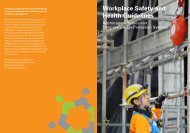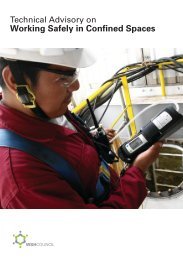Code of Practice - Workplace Safety and Health Council
Code of Practice - Workplace Safety and Health Council
Code of Practice - Workplace Safety and Health Council
You also want an ePaper? Increase the reach of your titles
YUMPU automatically turns print PDFs into web optimized ePapers that Google loves.
SECTION 4: EQUIPMENT<br />
4.1 General<br />
This section provides guidance for the selection, maintenance <strong>and</strong> other aspect <strong>of</strong> the lifting<br />
equipment.<br />
4.2 Selection <strong>of</strong> Equipment<br />
4.2.1 An equipment assessment must be completed as part <strong>of</strong> the RA. The objective <strong>of</strong> the<br />
equipment assessment is to identify the hazards <strong>and</strong> assess the risks associated with the equipment<br />
for the foreseeable range <strong>of</strong> lifting operations, for example, the applications, loads <strong>and</strong> configurations<br />
for which the equipment might reasonably be used. Based on this assessment, the appropriate lifting<br />
equipment for the lifting operation may then be selected.<br />
4.2.2 The equipment assessment shall consider, but not necessarily be limited to the following.<br />
• Is the equipment designed for this intended type <strong>of</strong> lifting operation?<br />
• What is the age <strong>of</strong> the lifting equipment?<br />
• Was there any authorised modifications made to the equipment?<br />
• What are the dismantling <strong>and</strong> assembly process?<br />
• How are components <strong>of</strong> the lifting equipment transported to site for assembly?<br />
• What type <strong>of</strong> pre-erection examination or Non-Destructive Testing (NDT) is required?<br />
• How is the lifting equipment controlled e.g. via pendant or within the operator cabin?<br />
• What are the access <strong>and</strong> egress for the operator to reach the cabin?<br />
• What are the dismantling <strong>and</strong> storage requirements?<br />
• What transportation methods to use for continued integrity?<br />
4.2.3 Owners <strong>of</strong> lifting equipment must not install additional components that may affect the<br />
structural integrity <strong>of</strong> the lifting equipment e.g., adding counterweights beyond what is specified in the<br />
manual. In general, structural modification <strong>of</strong> lifting equipment should not be undertaken except by a<br />
competent party. If the lifting equipment has to be modified, a detailed engineering design must be<br />
undertaken in consultation with the manufacturer or a pr<strong>of</strong>essional body. The design must take into<br />
account prevailing design codes, st<strong>and</strong>ards <strong>and</strong> practices as well as compliance with all applicable<br />
regulations.<br />
4.3 Equipment Positioning <strong>and</strong> Installation<br />
For the purposes <strong>of</strong> this CP, the term ‘positioning’ refers to mobile equipment being set up in a<br />
particular location to carry out lifting operations. The term ‘installation’ refers to the assembling <strong>of</strong> lifting<br />
equipment at the selected location.<br />
4.3.1 A process shall be established to ensure that the contractor reviews the positioning/installation<br />
<strong>of</strong> lifting equipment to eliminate or mitigate the risks. All hazards identified in relation to the position/<br />
Page 16 <strong>of</strong> 38

















